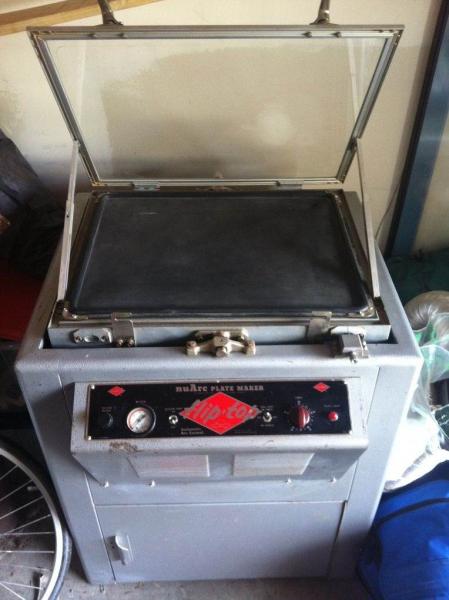Nu Arc Platemaker
Hello Fellow Craftsmen,
I’m looking on purchasing a platemaker and have run across one called a Nu Arc flip top. I’m only familiar with my old Anderson Vreeland and was wondering if there is a big difference between the vacuum on the AV and the plate glass on the Nu Arc? Is the pressure of the glass enough to make a plate with fine details?
Does anyone have any experience with these?
Thank you,
James

-1.jpg
If it’s working correctly the Flip-Top uses a vacuum to pull the plate and negative against the glass. You load it with the lid up, close the glass lid, turn on the vacuum, and when it has pulled up to maximum vacuum (note the gauge that tells the vacuum), flip it over and expose it using the timer. After exposure flip it back, turn off the vacuum, open the glass, and remove your plate and negative. It uses carbon rods for an arc light for exposure.
Bob
Does it have a bulp light source or a carbon arc? You can still use the vacuum and mount a light source above if it is the old carbon arc.
This unit is, I think, older than the one I used for years, but it still may be new enough to use a mercury-vapor lamp rather than a carbon arc to produce the UV light for exposure. Either way, remember to be respectful of both the volts/amps powering this innocent-looking box, and the intense UV light produced.
Thanks everyone. I know it uses carbon arc not mercury vapor lamps. It comes with a bunch of extras. This guy wants $500 for it, do you think it’s a good deal?
jtucker84, The carbon arc might not produce the
right spectrum for pp. Also it would have to be vented.
You would also need to sandwich kreen between the
neg and the plate. You also might have a hard time finding
replacement arcs “sticks” as they used to be called.
Here on earth your not going to pull more than 20lbs
of vacuum. best james
We called them “rods”.
Rods shouldn’t be too hard to find.
Try a theatrical supplier.
Check the rubber for cracks &
be sure it’s still soft to ensure a good seal.
The one in the studio where I worked
was not vented and
our studio was strictly up to code.
The model you show is one I’ve used
& it was absolutely my favorite.
I haven’t priced them for a while but
considering how common they were &
their (perceived) obsolescence,
$500 seems steep.
Calvert
KCMO
$500 is way too much for this. Even more when you consider it is not suited to making photopolymer plates.
The light source is so far from the plate that exposure times will be very long, and long exposures with carbon arcs will generate lots of fumes and some ash; the fumes are bad for you. I once made myself sick burning 20 offset plates in a row to carbon arcs.
The only way ot would be useable is, as already suggested, to just use the vaccuum frame and place a suitable light source over it, and that would be a bank of black light tubes.
Even then, exposing photopolymer plates in a glass contact frame has problems that are not present in a typical photopolymer unit, which uses an open face vaccuum plate with a flexible krene cover. Matte emulsion film and/or matte surface plates will give a better drawdown than slick surfaces. Plate material must be trimmed carefully on all four sides for good contact (no bumps!), and the flat must extend beyond the edge of the plate (that is, either an oversize negative or a negative stripped into masking material) or air may get trapped and prevent contact.
The point is, you could build a contact frame better for photopolymer for less than $500. All you need is a piece of formica or phenolic glued to a board, shallow thin sawcuts leading to a central hole, and the hole leading to a vaccuum pump, then a bit of krene. Very simple.
i think the government banned carbon arcs. i’ve had one for years and just this monday gave it away. i don’t think there is anyone who still sells the carbons.
I have one. Exposure times are VERY long and inconsistent. I abandoned it a couple of years ago - you can have it if you want to come to Fresno and pick it up.
After reading all your thought’s I think I’ll pass this one up and either build one myself or just use the old AV.
Thanks again.
Yow!
I had no idea they were that Hazardous.
Codes are changing all the time.
First time I made a carbon arc
it was w/a high school friend of mine.
I took two D batteries apart then
we hooked up 5 steam irons (set on wool) in series.
The tips need to touch & heat-up for a moment
before you can draw out an arc.
Too much fun.
Rats!
Calvert
KC